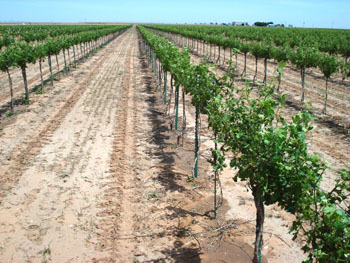Timing Cover Crops Drain Tiles More Info
Ed Hellman, Texas AgriLife Extension
Why irrigate?
Soil water availability has a strong influence on grapevine growth and its manipulation is a key vineyard management practice. Inadequate soil moisture:
- leads to water stress in the vine
- reduces vine growth and fruit yields
- can influence fruit quality, either positively or negatively, depending on timing and extent of stress
Abundant soil moisture can lead to excessive vine growth creating a shaded canopy that may be unfavorable for fruit quality and increase risk of fungal diseases. The principle tools for managing soil moisture are:
- supplemental irrigation to increase soil moisture
- competitive cover crops to reduce soil moisture
- mounding or raised beds
- drain tiles to reduce soil moisture
Each of these tools can be applied in different ways and times to modify soil water availability.
When do I irrigate?
Base the timing and quantity of your irrigation water on the desired effect on the grapevine. Monitor soil moisture content in the root zone to determine when to irrigate. Many different soil moisture sensors are available on the market; learn proper installation, maintenance, and operation procedures of the sensor you select. Collect, store, and review soil moisture data to guide timing of water applications. Use the evapotranspiration method to determine how much water to apply. Evapotranspiration (ET) is an estimate of the total water lost from the soil and plant system during a specific time period, and is used as a guide to determine how much water to replace to the system. Generally, mature producing vineyards do not require 100 percent ET replacement, because to do so often leads to excessive vine growth. Through experience, vineyard managers learn the percentage of ET to replace for a specific vineyard block to manage vine growth. Recently, “deficit irrigation” strategies that apply only 50 percent to 70 percent ET have been utilized in drier climates to deliberately impose water stress in vines to limit growth and possibly enhance fruit quality. Use considerable care with deficit irrigation, as excessive stress or improperly timed stress can reduce fruit yield and quality and possibly injure vines.
Cover Crop Management
Vineyard managers in growing regions that receive abundant spring and summer rainfall face the challenge of highly vigorous vines. As a result, they often utilize competitive cover crops on vineyard floors to reduce soil water availability. There are numerous options for cover crops. Consider factors such as:
- regional adaptation
- erosion control
- impact on soil nutrient content
- influence on the vineyard ecosystem including insects, fungi, and mammals
Manage established cover crops in response to the current season’s conditions and influence the extent of competition they exert for water. Distribution area, and therefore amount of competition from a cover crop, can be modified by managing the width of the covered alleyway through cultivation or herbicides; competition can be halved by removing cover crop in alternate rows. Similarly, specialized cultivation equipment can disturb only a portion of the cover crop to reduce competitiveness. Mowing height and frequency also influence water consumption by the cover crop. During periods of drought, supplemental irrigation may be needed if cover crop competition becomes too severe.
Drain Tiles
Subsurface drainage tiles may be installed to improve internal drainage and abate surface run-off that can occur when the underlying soil becomes saturated.
Recommended Resources
Irrigation water requirements for Arizona wine grapes, University of Arizona
Irrigation of Winegrapes in California, Practical Winery and Vineyard
Managing Salt-Affected Soils for Crop Production, Pacific Northwest Extension Publication (OR, WA, ID)
Irrigation Scheduling of Grapevines with Evapotranspiration Data
Winegrape Irrigation Scheduling Using Deficit Irrigation Techniques
Drain Tile Systems for Vineyards
Cover Crops Selection and Management in Orchards and Vineyards, University of California
Cover Crops in Orchards and Vineyards, Washington State University
Cover Crops in Organic Vineyards, Practical Winery and Vineyard
Irrigation Basics for Eastern Washington Vineyards, Washington State University
Reviewed by Jim Wolpert, UC Davis and Keith Striegler, University of Missouri


